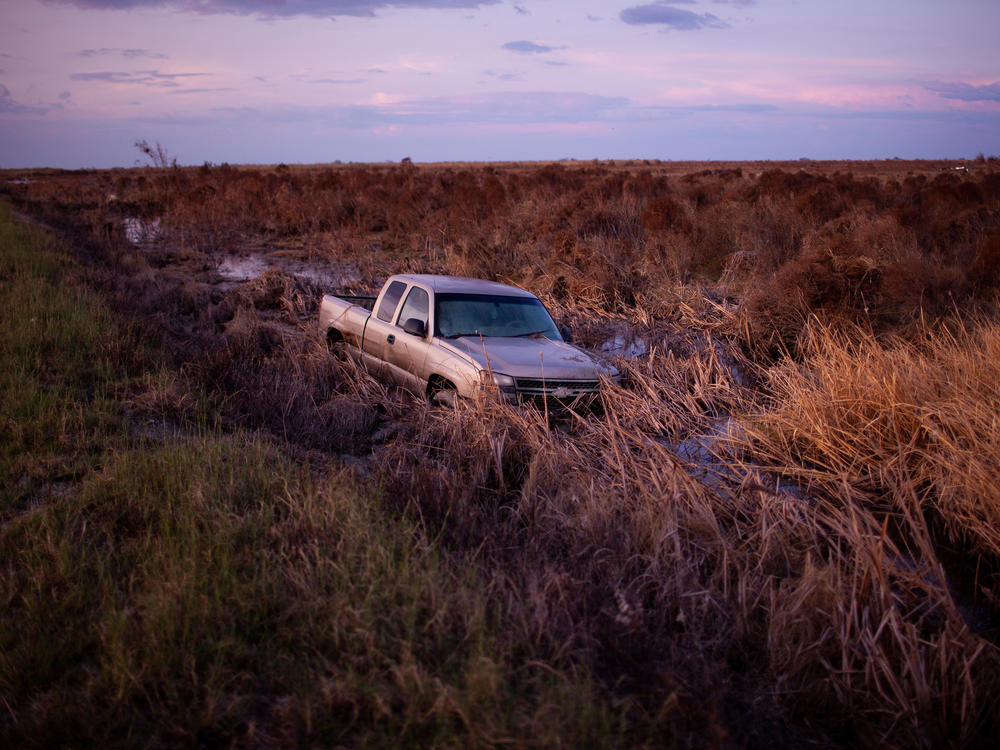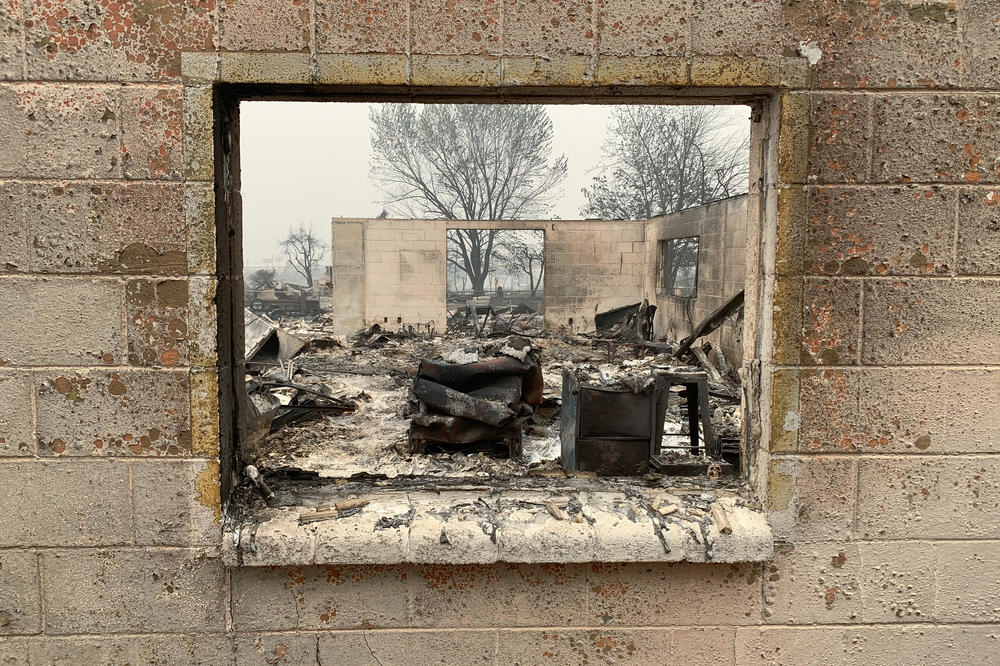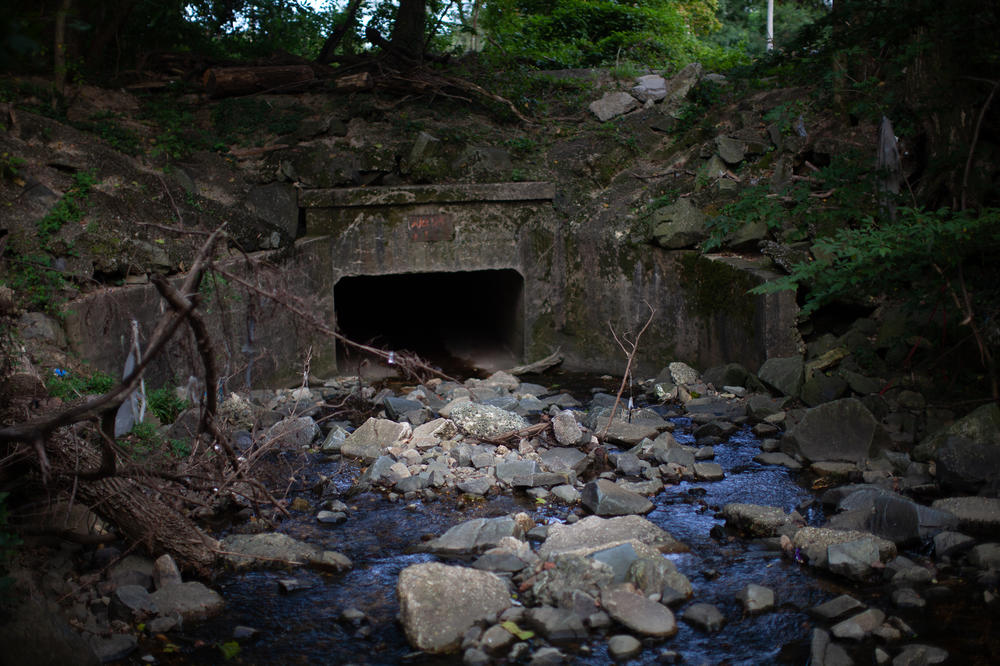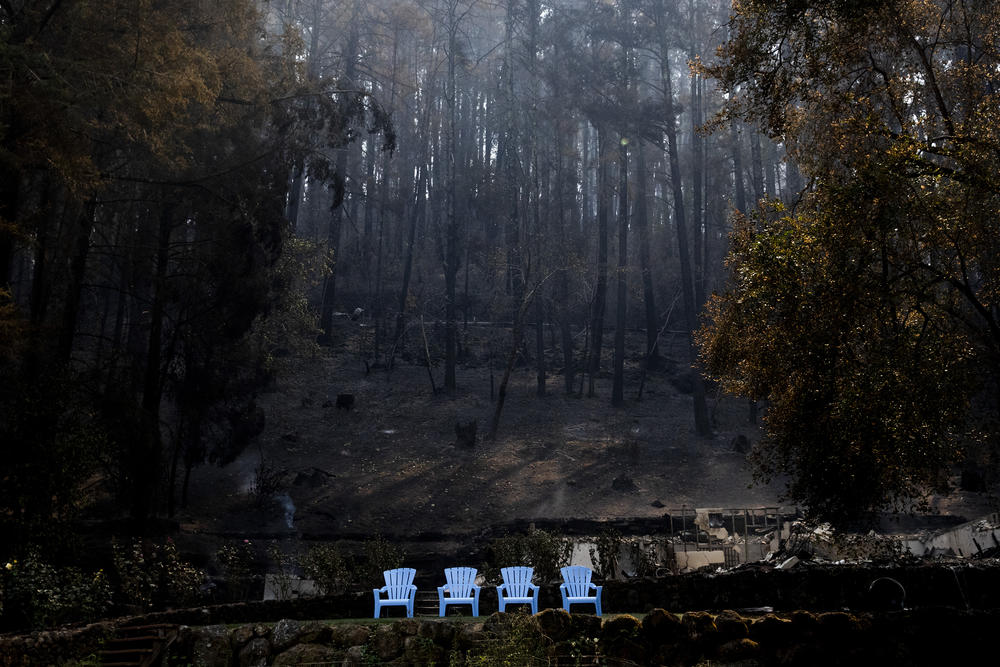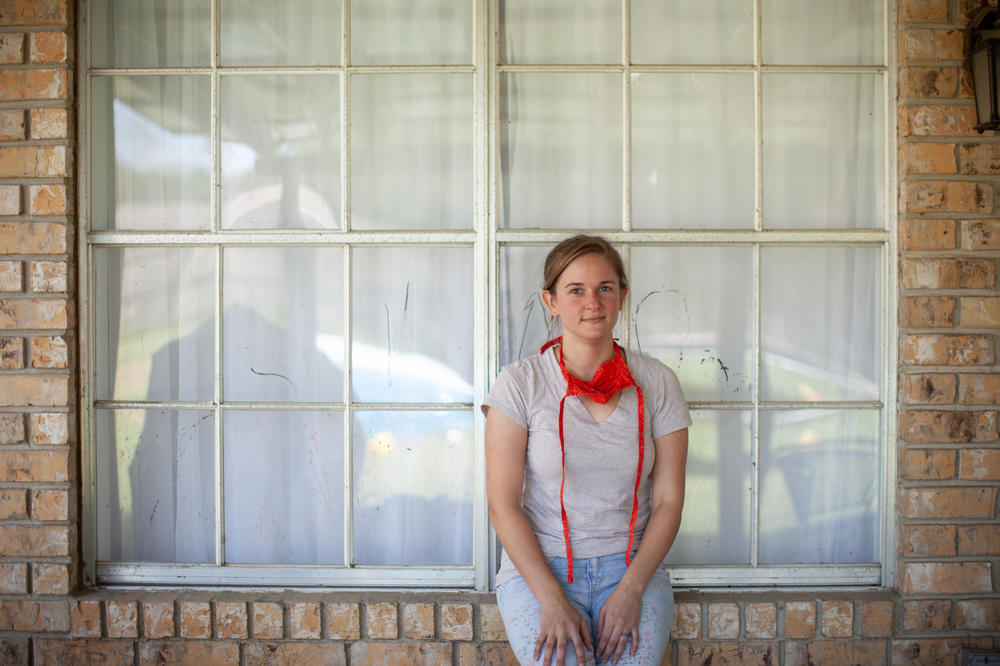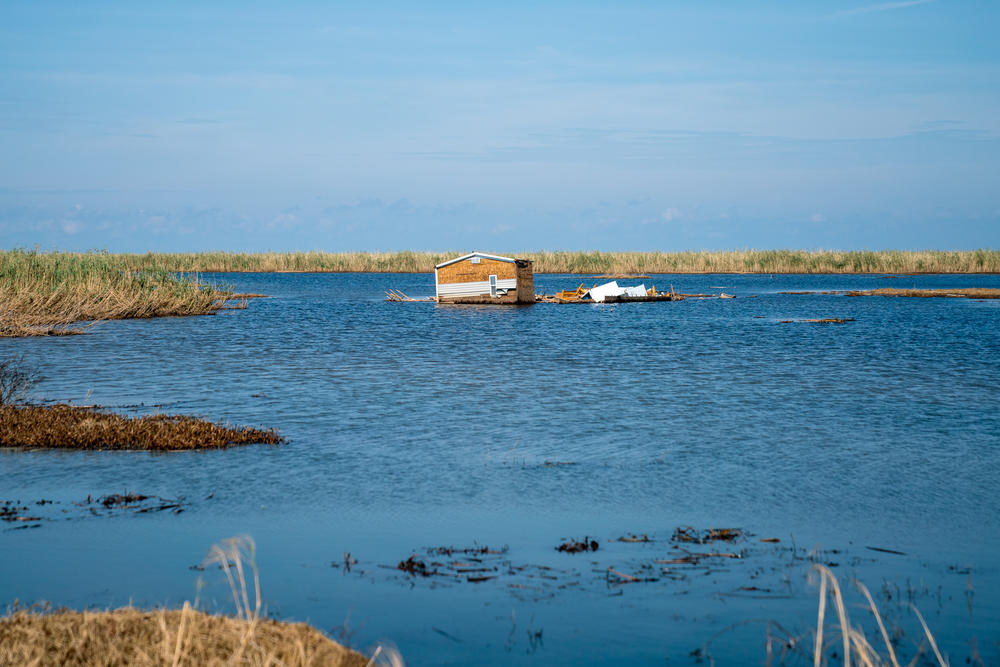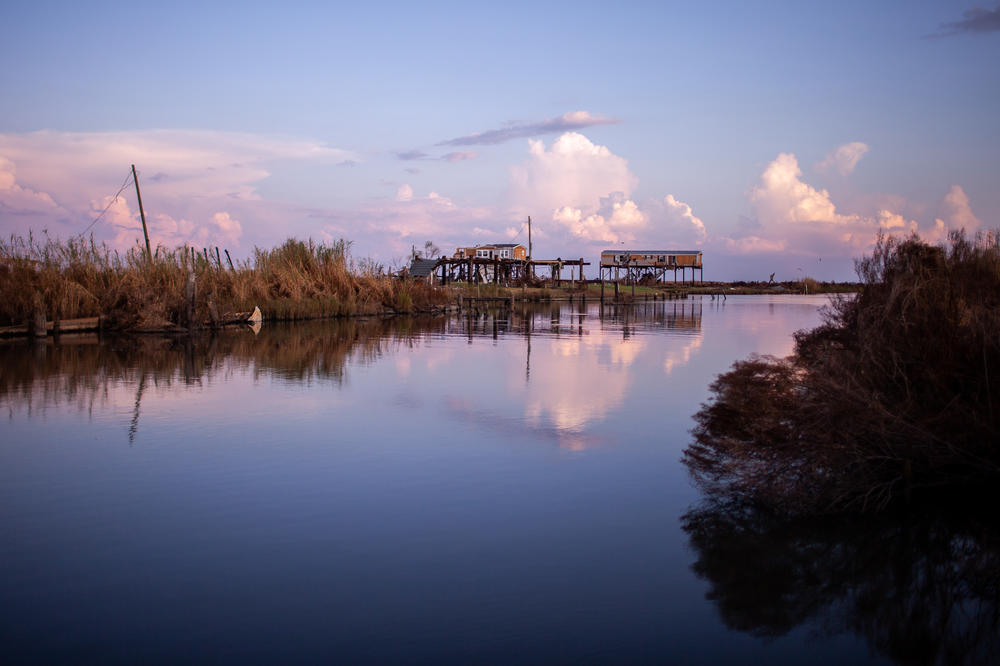Loading...
Section Branding
Header Content
Undisclosed: Most Homebuyers And Renters Aren't Warned About Flood Or Wildfire Risk
Primary Content
Each family had their reasons for ending up in harm's way.
For the Harts, it was the chance to have a large backyard in a quiet part of Ashland, Ore. The porch of the Baltimore house was perfect for Scott Harris' barbecue equipment. Kevin Boudreaux had grown up on the bayou and wanted to settle near his childhood home in Cameron, La.
Like millions of people every year who move, the families had access to a wide variety of information about everything from schools to public transit to lead paint. What they never learned, until it was too late, was that their homes all were in areas that are increasingly prone to flooding or wildfires.
None of the landlords, real estate agents, sellers, appraisers, bankers or home inspectors the families interacted with explained the risk of flooding or wildfires, because no one had to do so. Only about half of the states require that information about flood risk be disclosed to homebuyers, and just one state requires that such information be given to tenants. Only two Western states require disclosure of wildfire risk.
What's more, a growing body of research suggests that the flood and fire disclosure laws that do exist provide information in confusing ways or give too little information too late in the homebuying process.
That has led millions of people to bet their safety, their belongings and, in many cases, their financial futures on homes and apartments that are likely to be damaged or destroyed.
About 15 million properties, including both residences and commercial buildings, are at significant risk for flooding, and 4.5 million homes are at significant risk from wildfires. This year alone, Hurricane Laura inflicted at least $8 billion in damage to southwest Louisiana, and record-setting wildfires in California destroyed more than 9,200 structures. Numbers such as those will grow as climate change makes the Earth hotter, and floods and fires get more frequent and severe.
Every American pays the price for the lack of information, whether or not they have been directly affected by a flood or wildfire. The annual number of floods and wildfires that exceed $1 billion in damage has exploded in recent years. Between 2015 and this September, there were 28 such disasters. Taxpayers foot the bill directly when the federal government pays out billions of dollars in disaster relief.
Still, those who live in harm's way pay the highest price. Disaster assistance from the Federal Emergency Management Agency tends to help the affluent disproportionately, widening existing racial wealth gaps. Even if homeowners and renters have insurance against disasters, it is often not enough to make them whole. And the losses Americans suffer from floods and wildfires extend far beyond the financial, from lives lost to the toll on people's physical and mental health that can last for years.
"I liken it to a game of hot potato, and whoever ends up with that potato is going to end up owning and paying for the risk," says Alice Hill, who led disaster planning at the National Security Council under President Barack Obama. Hill argues that it should be the federal government's job to disclose flood and fire risk for residential properties, so that Americans can make informed choices about where to live.
Right now, she warns, millions of unsuspecting families don't realize they're living on the front lines of climate change and might pay heavily for it.
Wildfires didn't cross Christopher Hart's mind when he bought his home near Ashland, Ore., seven years ago. It's in a suburban neighborhood near a major freeway, not tucked into the heavily forested hills where fires have historically spread.
"It never occurred to me that a grass fire would take out my home and hundreds of other people's homes in a span of 12 hours," Hart says.
He was at work in early September when his wife got an alert that the Almeda Fire had broken out nearby. She and their 10-year-old daughter jumped into the car. "The flames were already coming into our yard," Hart says. "They sped away, and she said she could see flames in the rearview mirror."
Their home had been a "labor of love," with lush fruit trees in the backyard. In the debris pile that remains, they haven't been able to find family photos or mementos from his grandmother. They did find a mug, somewhat charred, with the words "cup of happy" written on the side. They're now in the process of negotiating with their insurance company.
Many people still picture forest fires when they think of wildfire. But in recent years, fires have leapt from wildlands and into dense suburban neighborhoods where residents never considered them a threat. In the West, most landscapes are primed to burn and are becoming increasingly risky in a warming climate. But only a handful of states actually map that risk, leaving most residents there in the dark.
Scott Harris found out he was living in a flood-prone area in 2018 — during a flash flood. By that point, Harris and his family had been living in their Baltimore home for 12 years. "We had no idea at all that there was even a concern about a flood plain," he says.
In fact, his block had flooded at least six times since the 1970s. But there was no way for Harris to know that. In Maryland, as in most states, there is no requirement to tell potential homebuyers about past flooding. The only information Harris would have received is if his house was in an official flood plain. But even that designation does not accurately convey future flood risk in many places because the flood maps don't take into account sea level rise or the growing threat of extreme rain due to climate change.
And in 21 states, including some on the front lines of climate-driven flooding, such as Massachusetts and Florida, there are no flood risk disclosure requirements at all.
The lack of information is a particular problem in places that aren't near obvious bodies of water. As in many flood-prone urban areas, the creek in Harris' neighborhood is in a pipe under the road.
In the end, the 2018 floodwaters stopped in Harris' yard and, luckily, didn't damage his home or any of the barbecue equipment he uses for his side business as a caterer. But his family is still affected by the flood risk. Now that they know they live in a flood zone, they have to pay for expensive flood insurance. He says it costs about $1,200 per year — a big expense that came out of nowhere. "I'm bent over a barrel," Harris says of the insurance costs. "I can't do anything else about it."
So, what if people had more information about climate hazards before they moved? Would they stop choosing to live in places that burn and flood?
California and Louisiana — two states on the front lines of climate change — offer some answers, although even their disclosure laws do not effectively warn many people about floods and fire.
Two weeks after fleeing their home, Thea Kendall-Osborne and Kelvin Osborne pulled up their driveway to see what remained after the fast-moving Glass Fire hit California's Napa Valley.
Four bright blue Adirondack chairs sit serenely on the lawn. Behind those, their two-story house is burned to the ground.
"The heat must have been intense," Osborne says, sifting through piles of drywall. "There's stuff that's just melted together." Kendall-Osborne lingers next to a burned-out car frame, the remnants of a prized '65 Mustang that belonged to her father.
Growing up in Southern California, Kendall-Osborne knew about wildfires. But after two decades of living elsewhere, it wasn't on her mind while she and her husband were looking for a house in Napa Valley.
"It didn't even occur to us," she says. "We literally got here in 2017, and two weeks later we had to evacuate because all of Napa was on fire. It was just like: This is not good."
In the hundreds of pages the couple received when they bought their home, a few sentences on a one-page form mentioned wildfire. Where they live, properties are labeled as potentially having "substantial forest fire risks and hazards."
That form makes California one of only two states in the West with any legal requirements to notify buyers about the wildfire risk they're taking on. Oregon's disclosure doesn't mention wildfires, only that a home is in the "forestland-urban interface." In California, being in a high-risk zone requires homeowners to clear flammable brush and vegetation, rules that are unevenly enforced.
Increasingly widespread and frequent wildfires and floods have led some residents in other states to demand more information about climate-related risks to their homes. Virginia's Legislature has considered two bills that would require flood disclosure, both of which have failed, and there's a similar bill pending in New York.
In California, starting next year, sellers must tell buyers if they're in compliance with vegetation-clearing rules and share a list of home retrofits to make houses more fire-resistant.
The Texas Legislature passed a law after Hurricane Harvey hit the state in 2017 requiring that buyers be informed if a house has flooded in the past, if it is in a flood plain or has flood insurance. The law does not require that tenants receive the same information, however, and some residents are pushing for the city of Houston to pass its own law covering those who rent.
Meanwhile, efforts to require flood risk disclosure as part of all real estate transactions nationwide have stalled in Congress.
Still, many disaster experts say flood and fire information is easily overlooked in a large stack of legal documents buyers must review. It may also be coming too late, after a buyer has already decided to move ahead with the purchase and put down a deposit. To help homeowners prepare for wildfires and floods, outreach may need to happen earlier in the home shopping process.
Louisiana has the most comprehensive flood disclosure law in the country: Prospective buyers must be told whether a home is in a designated flood zone, whether it has flood insurance and how much that insurance costs. And they get the information relatively early in the process, so they can factor it into their decision.
It's not a perfect law — it's still all but impossible to find out whether a house flooded before the current owners lived there, and how rising seas and more intense rain might affect future flood risk. But a study by the National Bureau of Economic Research home prices suggests that Louisiana residents are factoring flood risk into their housing decisions more than other Americans.
Still, for many families, the benefits of living in a flood-prone place outweigh the risks.
Kevin Boudreaux grew up in Cameron Parish, La., on the Gulf of Mexico. The area is flat and marshy, and sea level rise threatens to swamp what little dry land exists.
Kevin and his wife, Susan, understand they live in a flood-prone place. Their home was destroyed by hurricane storm surge in 2004. They rebuilt it on stilts. The house was damaged again by storm surge in 2008, and they repaired it again.
The frequent floods have led a lot of people to leave Cameron Parish. Between 2000 and 2010, the population fell by about one-third. Many of those who remain are short-term oil and gas workers. Others are retirees looking for an ocean view. The Boudreauxs are part of a third group: people who are too attached to the place to leave.
In August, Hurricane Laura pushed an estimated 17 feet of ocean water into Cameron Parish. The Boudreauxs' house survived the deluge, but the storm scraped the neighbors' houses clean off their concrete foundations and washed away the Boudreauxs' lumber store and recreational vehicle park.
A month later, it was clear that the lumber store was a total loss, and they were focused on fixing the damage at the RV park. "It's our only income," Susan Boudreaux says as she wrestles with a leaky water pipe.
Their plan is to get the park up and running and hope that their tenants — workers at a new natural gas facility — return quickly.
Asked whether she's ever considered moving somewhere with less flood risk, she laughs. "We've never lived anywhere else," she says. "Kevin grew up right over there."
She points across the street, past a line of uprooted trees. "I tell everybody, my roots are deep," she says. "Where would we go? This is home."
Copyright 2020 NPR. To see more, visit https://www.npr.org.
